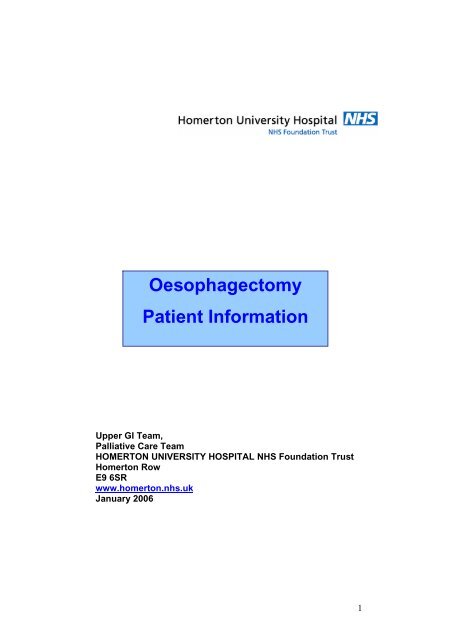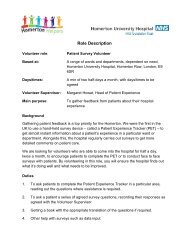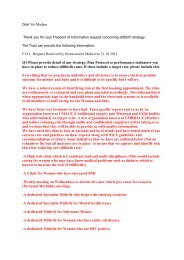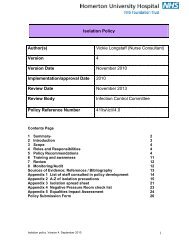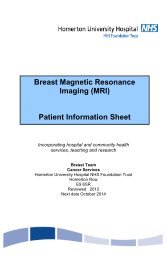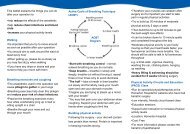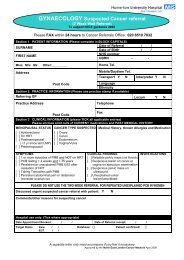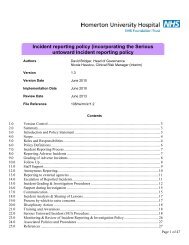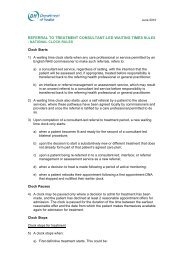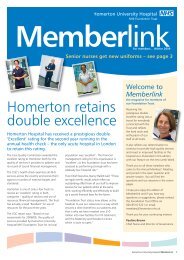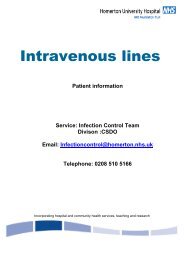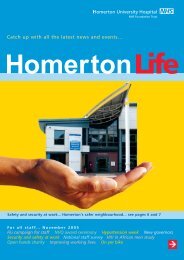Oesophagectomy leaflet - Homerton University Hospital
Oesophagectomy leaflet - Homerton University Hospital
Oesophagectomy leaflet - Homerton University Hospital
Create successful ePaper yourself
Turn your PDF publications into a flip-book with our unique Google optimized e-Paper software.
<strong>Oesophagectomy</strong>Patient InformationUpper GI Team,Palliative Care TeamHOMERTON UNIVERSITY HOSPITAL NHS Foundation Trust<strong>Homerton</strong> RowE9 6SRwww.homerton.nhs.ukJanuary 20061
This <strong>leaflet</strong> provides information about oesophagectomy. We hope thisinformation will help answer some of your questions and concerns in addition tothe on-going discussions that you will have with the consultants and nursesinvolved in your care. We want you to understand your disease so that you canmake informed decisions about your care.Cancer of the Oesophagus (gullet)Cancer of the oesophagus is a malignant growth in the gullet. Gullet is a longtube which connects your throat to the stomach. The most common symptom isthe cancer causing difficulty in swallowing.It is the 9 th most common cancer in UK and approximately over 7,000 newcases are diagnosed each year.More information about cancer of the oesophagus and the treatment optionsare available on our Cancer of the Oesophagus factsheet.<strong>Oesophagectomy</strong> (surgery)Cancer of the oesophagus can be treated using surgery, chemotherapy orradiotherapy. The choice of treatment will depend upon the stage of the cancer,its position and size, as well as your age and general health. The treatmentscan be used alone or in combination.An oesophagectomy is the surgical removal of the oesophagus. Surgery is themost common treatment for the cancer of the oesophagus.Your test resultshave shown that the cancer can be removed by an oesophectomy . It is doneunder general anaesthetic. You will be asleep for the entire operation. Theseare all majoroperations with risks involved and sometimes recovery can take time.It is difficult to say how long your operation will take as every patient is uniqueand every operation is different. As mentioned before it is a major opeartionand can take several hours.Before surgeryBefore your surgery you will have had a number of tests and scans includingendoscopy, CT scans and EUS scans. More information about these scans isavailable on our Cancer of the Oesophagus factsheet.The surgeon and anaesthetist will see you before your operation. The surgeonwill once again explain how the operation will be done and you will have to signa consent form. If you have any questions or are not sure and worried aboutanything it is important to ask them now.The evening before your operation you may eat or drink as normal. Usually nofood is allowed six hours, and no water two hours before the operation. Youmay have a drip into your arm. If you are diabetic you may be given an infusionof glucose and insulin to control your blood sugars.2
You will be given a pair of stockings to wear. It helps to reduce the risk of deepvein thrombosis (blood clotting in the leg vein). You will change into a theatregown and remove any jewellery. The anaesthetist will discuss paincontroloptions with you. In the anaesthetic room youwill be given an epidural. It is a fine plastic tube inserted into your back near thespinal cord. Continuous painkillers can be given through the epidural. If you donot want an epidural there are other ways of having painkillers. PCA (paincontrol analgesia) is the most common, where you can give yourself a dose ofintra-venous pain relief when you feel pain. However, the surgical team will letyou know exactly when you can start to drink and eatThe anaesthetist will give an injection, which will send you to sleep.The OperationThere are different ways of of doing the operation. Your surgeon can approachthe cancer via neck, chest or tummy (abdomen). The suitability of the operationdepends mainly on where the cancer is situated in the oesophagus. You mayhear words like Trans-thoracic oesophagectomy or Trans-hiataloesophagectomy, this describes the surgeon’s approach to the surgery. Theoperation involves:• Removing the affected part of the oesophagus and joining up theintestine again• Reshaping the stomach and allowing it to be pulled up into the chest• Removing the surrounding lymph nodes that may have cancer in them• Joining the stomach to the remaining oesophagus in the chest• Inserting a temporary feeding tube into the small bowel (jejunum)Diagram showing the oesophagus and other digestive partsDuring this operation, because the top part of the stomach is usually removed,the position of the stomach will be higher than before. This process will helpyou to swallow the food and eat as before (see Figure 1). But you may need tosmaller and frequent mealsAfter your operationWhen you wake up you will be in the Intensive Care Unit (ICU). This is normaland does not mean that anything has gone wrong. As mentioned before,because this is a big operation during your stay in the ICU you can receive very3
inensive nursing care with lots of monitoring. You will soon be transferred to award.When you wake up there will be several tubes attach to you. The tubes you willhave are:A drip (intravenous infusion) will be used to maintain the body's fluids until youare able to eat and drink again.You may also have a plastic drain in each side of your chest (chest drains).They will be removed after 3-5 days after your operation.There will be some discomfort and pain in the area of the operation. We aim tocontrol the pain as much as possible by using a device called epidural. Painrelieving drugs are given through an Epidural which is a tiny little palstic tubethat goes in your spine while you are sleep. The drugs numb the pain. It isimportant to take the medication so that you can cough and move around asmuch as possible. Your Anaesthetist will discuss this with you before youroperation.You may also have some tubes in your abdomen (tummy), chest and downyour nose. The doctor will discuss and explain the purpose of them. They willbe removed as soon as possible.After your operation you will be encouraged to start moving about as soon aspossible. This is to prevent chest infection and an essential part of yourrecovery. If you have to stay in bed the nurses will encourage you to do regularleg movements and deep breathing exercises. There will be a physiotherapistworking with you to help you after your operation, who can help you to do theexercises.Approximately five days after your surgery you will be given a special drink andhave an x- ray of your tummy. This special x-ray is to check that the join insidehas sealed and that there is no leakage in that area. You will not be able todrink until you have had this test This will be gradually increased and after afew days you will be allowed to start drinking again normally.The stitches or clips that you have on your abdomen will be removed about tendays after your surgery. You will probably be ready to go home about twoweeks after your operation, once your stitches have been removed. However,you will need to take rest at home, and it may take upto three months beforeyou can carry out your normal activites.If you think you might have problems when you go home - for example, if youlive alone or have several flights of stairs to climb - let the nurses or socialworker know when you are admitted to the ward, so that help can be arrangedwhen you go home.Before you leave hospital you will be given an appointment for a post-operativecheck-up at the outpatient clinic. This is a good time to talk to your doctor aboutany problems you may have after your operation.4
Are there any complications from the operation?<strong>Oesophagectomy</strong> is a major operation and there are some complications. Wemake all attempts to minimise the risk.• The commonest problem that patients have is with their lungs, especiallyif there is a cut in the chest. To avoid this it is important to follow theexercises the physiotherapist has recommended.• The other rare but serious complication can be any leakage from thearea of the operation. As mentioned before, we will check for this beforeyou start eating and drinking.Life Style ChangesYou will be able to eat small meals and frequent meals.Gradually you will start to feel better and soon you will be able to eat more. It isimportant to keep trying to build up your strength.Due to the new arrangement sometimes swallowing can make it feel difficultand lumpy first. Eating soft but solid food helps to naturally exercise the join andkeep it open. Avoid hard and sharp food pieces during the first few weeks.Sit upright when you eat or drink to help the food go down.It can be very helpful to talk to a dietician before, or soon after, your operation.They can give advice and information about managing your diet. At <strong>Homerton</strong><strong>Hospital</strong> we have a Dietetic Department, run by a Senior Dietician and his team.The staff on the ward can arrange for one of them to visit you. If at any time youhave any problems with your diet, the hospital dietitian will be able to offer youadvice and practical help. Your GP may also be able to refer you to acommunity-based dietitianWhat are other treatment options?Non surgical treatment option will not cure you. Because every person’s cancerdiagnosis and their treatment is different, there is no standard treatment for thiscancer.The Upper GI TeamThe Upper GI team describes the many professionals that are involved inplanning all aspects of your care. The team consists of doctors, nurses,endoscopists, radiologists, oncologists, dieticians and many more. Keymembers of the team meet weekly to discuss and plan your care. This is calledthe Multi-Disciplinary Team (M.D.T)Your Keyworker: …………………………………….5
Contact No: …………………………………………..Consultant: …………………………………………..Contact No: …………………………………………..Consultant oncologist: …………………................Contact No: …………………………………………...If you have any further questions that are not answered in this <strong>leaflet</strong>, speak toa member of your care team.Further Information<strong>Homerton</strong> Health ShopThe Health Shop is a drop in Health and Cancer Information Centre, based at the mainentrance of the hospital. Provides information and support on cancer and different health topics.<strong>Homerton</strong> <strong>University</strong> Hospaital, <strong>Homerton</strong> Row, London, E9 6SRMacmillan Cancer Information Manager Tel No: 0208 510 5191. Health ShopTel No: 0208510 7733www.homerton.nhs.ukCancer BackupSpecialist Nurses provide information and support by telephone, email and letter andsomeplaces face-to-face. Produce booklets and factsheets on all aspects of cancer.Telephone translation service for those whose first language is not English.3 Bath Place, Rivington Street, London, EC2A 3JRNational Helpline No: Freephone 0808 800 1234 (Mon-Fri, 9am-7pm)www.cancerbackup.org.ukDigestive Disorder FoundationProduce patient information <strong>leaflet</strong>s on many digestive disordersPOBox251, EDGWARE, Middlesex, HA8 6HGwww.digestivedisorders.org.uk/Macmillan CancerlineFree information and emotional support for people living with cancer.Telephone translation service for those whose first language is not English.89 Albert Embankment, London, SE1 7UQNational Helpline No: 0808 808 2020www.macmillan.org.ukOesophageal Patients AssociationInformation <strong>leaflet</strong>s and support provided by former patients.16 Whitefield Crescent, Solihull, West Midlands, B91 2JYTel No: 0121 704 9860 (Mon-Fri, 9am-7pm)www.opa.org.uk6


